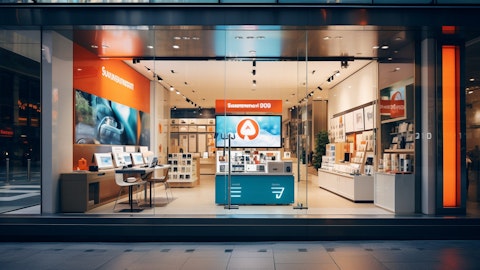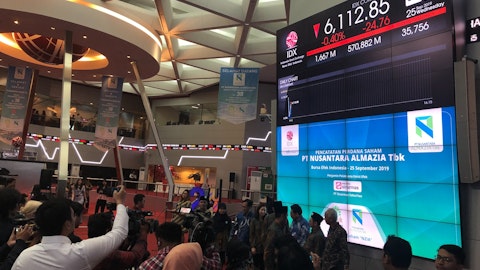Alibaba Group Holding Limited (NYSE:BABA) Q3 2024 Earnings Call Transcript February 7, 2024
Operator: Good day, ladies and gentlemen. Thank you for standing by. Welcome to Alibaba Group’s December Quarter 2023 Results Conference Call. At this time, all participants are in a listen-only mode. After managements prepared remarks, there will be a Q&A session. I would now like to turn the call over to Rob Lin, Head of Investor Relations of Alibaba Group. Please go ahead.
Rob Lin: Good day, everyone, and welcome to Alibaba Group’s December quarter 2023 results conference call. With us are Joe Tsai, Chairman; Eddie Wu, Chief Executive Officer; Toby Xu, Chief Financial Officer. We have also invited Jiang Fan, CEO of Alibaba International Digital Commerce Group, AIDC, to join the call. This call is also being webcasted on the IR section of our corporate website. A replay of the call will be available on our website later today. Now let me cover the safe harbor. Today’s discussion may contain forward-looking statements including without limitation, statements about our new organization and government structure, strategies and business plans as well as our beliefs and expectations about our business prospects such as the future growth of our business, revenue and return on investment.
Forward-looking statements involve inherent risks and uncertainties that may cause actual results to differ materially from our current expectations. For detailed discussions of these risks and uncertainties, please refer to our latest annual report on Form 20-F and other documents filed with the U.S. SEC. or announced on the website of the Hong Kong Stock Exchange. Any forward-looking statements that we make on this call are based on assumptions as of today, and we do not undertake any obligation to update these statements, except as required under applicable law. Please note that certain financial measures that we use on this call, such as adjusted EBITDA, adjusted EBITDA margin, adjusted EBITA, adjusted EBITA margin, non-GAAP net income, non-GAAP diluted earnings per share or ADS and free cash flow are expressed on a non-GAAP basis.
Our GAAP results and reconciliation of GAAP to non-GAAP measure can be found in earnings press release. Unless otherwise stated, growth rate of all stated metrics mentioned during this call refers to year-over-year growth versus the same quarter last year. With that, I will now turn to Eddie.
Eddie Wu: Hello, everyone. Over this past quarter, we delivered steady growth while making organizational adjustments that align with our strategic focus. At the same time, we took a deep look at our core business operations and the competitive landscape. We concluded that to maintain our competitive edge, we increase our investment in core capabilities and adopt a more aggressive approach towards competition in order to win growth. Our top priority is to reignite the growth of our two core businesses, e-commerce and cloud computing. During the quarter, the execution of our user-first and competitive pricing strategies in Taobao and Tmall Group, TTG was effective resulting in healthy year-over-year GMV growth as the number of active buyers and order volume showed a robust increase.
The number of merchants continue to grow at a double-digit rate, and I’ll elaborate on the outlook and plans for 2024 in a moment. In Cloud Computing, we’re committed to our strategy of prioritizing public cloud. We have proactively optimized our business structure, reduced revenue from project-based contracts and increased investment in public cloud products. These structural adjustments are showing results and Alibaba Cloud’s overall profitability capability continues to improve. We’ve also upgraded Alibaba Cloud’s sales operations establishing different sales and service systems to serve different types and sizes of customers by improving our customer coverage and service capabilities, we will enhance our growth rate. In the International Commerce business, we focused on expanding cross-border offerings and enhancing the shopping experience.
This quarter, all of AIDC’s retail platforms achieved growth resulting in international digital commerce overall revenues growing at a rapid rate of 44% year-over-year. Cainiao continued to develop its global smart logistics network with cross-border logistics fulfillment solutions contributing to 24% and year-over-year revenue growth as well as realizing strong synergies with the cross-border e-commerce business. Next, I’d like to share the strategic priorities for TTG in investing and capturing growth opportunities. TTG operates in the world’s most competitive e-commerce market, which is China. As we carefully evaluate TTG’s competitive position within the China e-commerce market, we note that TTG continues to be number one in GMV share and is the leading platform for consumer shopping.
Merchants operate on the platform as their primary place of e-commerce business, and TTG has the deepest and most comprehensive selection of products amongst its peers. However, we must still make targeted investments and improvements in price competitiveness, service and user experience. Given that consumers use multiple platforms, returning to a user-centric approach is at the heart of our strategy. We’ll increase investment in core user experiences to enhance the customer shopping experience. I’m confident that by focusing on delivering the incredible Taobao or universal Taobao experience, offering quality products at attractive prices with great service meeting the different needs of different consumer segments, TTG will earn users’ trust and return to growth.
Thus, 2024 will be a year of comprehensive capability upgrades for TTG and also a year of significant investment and we’ll be prioritizing investment in the following areas. One, product supply. And we’ll increase our investments in growing the selection of branded and products and direct for manufacturer products on TTG’s platform. This will further strengthen our product supply advantages to better address new consumption trends and demands. Two, competitive pricing and efficiency. We’ll increase investment into product sourcing capabilities and optimizing business model relationships between merchants and our platform. For different types of suppliers, we’ll offer flexible business models that are best suited to improve their operational efficiency and thereby enhance Taobao’s value proposition.
The competitive pricing we’re focused on delivering is attractive prices for quality products. This is a demand that consumers have across cycles and is fundamental to doing business. Three, quality service. We will work with our merchants and logistics partners to invest in improving the entire consumer service experience including presale, in-sale, post-sale and logistics. For different customer segments on the platform, we will build a consumer service system that accurately identifies and meets the various needs of the different groups. Fourth, increased purchase frequency. Through the above investments, we will enhance our comprehensive capabilities to offer quality products at attractive prices with great service. We believe that improving the platform’s overall shopping experience and service quality will lead to increased purchase frequency and materially improve the efficiency of user growth.
Today, Taobao and Tmall remain the most valuable shopping platforms and the main place for merchants to do business. With the comprehensive capability planning — building plan for 2024, we’re confident that TTG will return to growth. Next, I’ll hand over to Jiang Fan to present on ADC.
Jiang Fan: Good evening, everybody. Over the past quarter, despite the uncertain international environment and more intense market competition, AIDC achieved rapid growth. Total orders grew by 24% year-on-year driven by strong growth across all major retail platforms. Growth in our cross-border business was especially significant. Our three major growth drivers are; first, enhanced consumer experience as a result of our business model and supply chain services upgrade; second, product and technology innovation; and third, our targeted expansion in priority markets. Next, I will present our business results and future development plans around these three drivers. First is our business model and supply chain services upgrade. Last quarter, AliExpress achieved year-on-year order growth of over 60%.
This was mainly driven by the new AE Choice model that we launched in early 2023. The AE Choice model is, in essence, an upgrade that we made to our original pure platform model into a hybrid business model that combines POP on the one hand with a fully entrusted model on the other and it’s underpinned by supply chain efficiency. It optimizes supply on the platform by balancing experience with richness of offerings. By offering entrusted cross-border logistics, marketing and other services, we lower the barrier for merchants to engage in cross-border business, bringing more certainty to their operations and more diverse assortment to the platform. At the same time, we continue to enhance the end-to-end consumer experience including by providing more stable product quality and more competitive prices by continuing to optimize delivery time and by adding value-added services like local product return.
As of January 2024 choice already made up half of all AliExpress orders. It’s a high-quality user experience has driven significant user growth and transaction growth on the AliExpress platform. And going forward, we’ll continue to invest resolutely to further increase choice penetration and provide a better experience to more users. In terms of product and technology innovation, AIDC serves consumers in different countries and regions around the world. We’ve already optimized products in certain key countries and regions in line with local preferences. These efforts have been highly appreciated, and we’ll continue to pursue that kind of innovation and upgrading. We’re also actively deploying AI to enhance operating efficiency and lower barriers for merchants.

Our suite of AI-based digital foreign trade products have been officially launched, enabling real-time language translation AI and logistics services, rapid generation of images and videos for marketing, et cetera. Third, sustained growth in key markets. In the last quarter, we achieved good growth in different regional markets. And in certain key markets, A achieved breakthrough rapid growth to become the leading platform locally. In Turkey and neighboring markets, Trendyol continue to achieve robust double-digit order growth and maintained its leading position in the Turkish market. It also further expanded its business in valuable new markets in the Middle East. In Europe, alibaba.com completed its acquisition of the well-known European B2B digital trade platform, Visable, further expanding its supplier base in the region and further advancing alibaba.com’s global expansion and dual brand strategy.
There is huge potential for AIDC to increase user penetration in the majority of overseas markets, building on our current resources and footprint, we will increase our investment in select regional markets where we see opportunities and value to achieve opportunities for high certainty and healthy growth. Going forward, we’ll continue to maintain our rapid growth momentum and provide consumers with improved differentiated services. To that end, we’ll continue to increase our investments in enhancing user experience and business competitiveness while expanding our business scale.
Toby Xu: Thank you, Jonathan. We achieved a healthy financial performance in the past quarter, driven by steady business momentum and improving operating efficiency in several major businesses. Total consolidated revenue was RMB260.3 billion, an increase of 5%. Consolidated adjusted EBITDA increased by 2% to RMB52.8 billion. Our non-GAAP net income was RMB48 billion, a decrease of 4%. Our GAAP net income was RMB10.7 billion, a decrease of RMB35 billion. That was primarily attributable to change in investment values and impairments. Firstly, there was a market-to-market change from our equity investments of about RMB19 billion; second, amortization impairment of intangible assets was RMB14.6 billion, of which RMB12.1 billion was related to Sun Art impairments.
Third, impairment of goodwill was RMB8.5 billion related to Youku. The above three items were excluded from non-GAAP net income. As of December 31 2023, we continue to maintain a strong net cash position of RMB487 billion or $68.6 billion. Free cash flow this quarter was RMB56.5 billion, a decrease of 31%. The decrease in free cash flow was attributed to increased CapEx in several onetime factors, including timing of income tax payments and working capital changes related to several of our businesses. Now let’s look at the segment results. Starting with Taobao and Tmall Group. Revenue for Taobao and Tmall Group was RMB129.1 billion, an increase of 2%. During this quarter, we made steady progress to execute our Taobao and Tmall strategies. We observed a few positive trends.
As Eddie mentioned, our online GMV achieved healthy growth with order volume growing strongly during the quarter. Notably, the order volume exited double-digit year-over-year growth during the second half of the quarter. Importantly, we continued our efforts to onboard our wide range of brands and merchants. The number of operating merchants on our platform continued to grow at double digits, and this trend has sustained over the past four quarters. Additionally, we are also seeing strong growth in paying merchants. Customer management revenue was RMB92.1 billion, relatively flat year-over-year. The overall take rate decreased slightly year-over-year mainly because of the increase in GMV came from Taobao merchants. The mix shift of GMV towards Taobao merchants provide us with further monetization potential because the take rate from Taobao merchants has been improving, while Tmall merchants take rate was unchanged during the quarter.
Importantly, this trend also reflects increasing consumer demand of price-competitive products offered on our platform. Direct sales and other revenue increased 2% to RMB31.6 billion. China commerce wholesale business revenue increased 23% to RMB5.3 billion, primarily due to an increase in revenue from value-added services of 1688.com. Taobao and Tmall Group adjusted EBITDA increased by 1% to RMB59.9 billion. The increase was primarily due to the narrowing losses in certain businesses partly offset by the increasing investment in content, user acquisition and retention of Taobao EPP as well as technological innovation. We are in the process or revitalizing Taobao and Tmall Group and position it for future growth. We are beginning to see early signs of GMV growth recovery driven in part by investment made since earlier this fiscal year.
We still have a lot of work ahead. As Eddie mentioned, we will invest for future growth and strengthen Taobao and Tmall Group’s market leadership. Our Cloud Intelligence Group’s revenue quality continues to improve as we proactively reduced revenue from low-margin project-based contracts. Additionally, we recorded healthy growth of our public cloud revenue from external customers. Revenue from Cloud Intelligence Group was RMB28.1 billion this quarter, an increase of 3%. Cloud’s adjusted EBITA increased by 86% to RMB2.4 billion. The continuous improvement in our adjusted EBITDA reflected improving product mix through our focus on public cloud and operating efficiency, but enhance the profitability of Cloud business gives us confidence to invest in technology and customers to strengthen our public cloud leadership in the future.
Alibaba International Digital Commerce Group revenue was RMB28.5 billion, an increase of 44%. Revenue from International Commerce Retail Business increased by 56% to RMB23.3 billion, the increase in revenue was primarily due to solid revenue growth from AliExpress, especially Choice business and Trendyol. Revenue from our International Commerce Wholesale business increased by 8% to RMB5.3 billion, the increase was primarily due to an increase in revenue generated by cross-border related value-added services from alibaba.com. AIDC’s adjusted EBITA was a loss of RMB3.1 billion. Losses increased primarily because of the increase in investment in AliExpress Choice, Trendyol’s international business partly offset by improvement in monetization across all major platforms.
Overall, we have seen a very rapid order and revenue growth of our AIDC cross-border e-commerce business over the last few quarters. To sustain this momentum and provide differentiated services to customers, we increased the investment during this quarter, and we’ll step up investments to drive further growth. Total revenue from Cainiao grew 24% to RMB28.5 billion, primarily contributed by the increase in revenue from cross-border fulfillment solutions. Cainiao adjusted EBITDA was RMB961 million compared to a loss of RMB12 million in the same quarter last year. The increase reflected economies of scale that leads to cost optimization as well as optimize operating expenditure spending in the coming quarters as a strategic partner of AliExpress.
We will increase investments in expanding our cross-border logistics capabilities to support a Choice’s growth. Local services group revenue in December quarter grew 13% to RMB15.2 billion, driven by healthy growth of Ele.me and rapid growth of Amap. Local service Group adjusted EBITDA was a loss of RMB2.1 billion this quarter compared to a loss of RMB2.9 billion same quarter last year, primarily due to the continued narrowing of loss from our two home business, driven by Ele.me improved unit economics and increasing scale. Revenue from our DME group was RMB5 billion, an increase of 18%, primarily driven by the strong revenue growth of off-line entertainment businesses. Adjusted EBITA was a loss of RMB517 million compared to a loss of RMB391 million same quarter last year.
Losses increased primarily due to the increased losses of Youku. Revenue from all other segments decreased 7% to RMB47 billion, mainly due to the decrease in revenue from Sun Art. Adjusted EBITDA from all other segments was a loss of RMB3.2 billion compared to a loss of RMB1.7 billion in the same quarter last year primarily due to increase in year-over-year loss from Sun Art due to scale down of certain of businesses. Excluding Sun Art, flushable and in-time businesses that have physical retail operations, group revenue would have grown at approximately 8% in our group consolidated adjusted EBITDA margin would have been 4 percentage points higher at approximately 24% this quarter. Lastly, we remain committed to returning cash to shareholders.
We have been consistently buying back shares. In the 12 months ended December 31, 2023, we have repurchased $9.5 billion in shares and have reduced the share account by 3.3% of accounting for shares issued under our ESOP. Additionally, quarter-to-date until February 6th, we have repurchased another $1.4 billion worth of our shares. Our Board of Directors has approved upsize of the share repurchase program by another $25 billion through March 2027, upsizing our share repurchase program demonstrates our strong confidence in our business fundamentals and cash flow generation capability. Following the upsize, we currently have $35.3 billion available under our share repurchase program. The upsize program will allow us to achieve a net reduction in share count and achieve EPS and cash flow per share accretion.
Subject to market conditions, we target to achieve at least 3% in annual reduction in total shares outstanding for the next three fiscal years. Thank you. That’s the end of our prepared remarks. We can open up for Q&A.
Rob Lin: Everyone, for today’s call, you are welcome to ask questions in Chinese or English. A third-party translator will provide consecutive interpretation for the Q&A session. Please note that the translation is for convenience purpose only. In the case of any discrepancy, our management statement in the original language will prevail. If you are unable to hear the Chinese translation, bilingual transcript of this call will be available on our website within seven working days after the Chinese New Year holiday. Operator, please connect the speaker and SI conference line right now and start the Q&A session when ready. Thank you.
See also 15 Best Acne Treatment Products For Teens in 2024 and Top 15 Best-Selling Cancer Drugs.
Q&A Session
Follow Alibaba Group Holding Limited (NYSE:BABA)
Follow Alibaba Group Holding Limited (NYSE:BABA)
Operator: [Operator Instructions] Your first question comes from Ronald Keung with Goldman Sachs. Please go ahead.
Ronald Keung: I want to ask about the Taobao Tmall take rate this quarter that we just mentioned a Slide 4 and the blended take rate. You mentioned about the different factors, the mix shift, but also Taobao take rate increase. So, I want to hear what is driving the take rate increase on the specific particularly on Taobao, how is the adoption of our sales base and the cost per sales based shift in our ad tech upgrades and just on the blend of this, then how should we — when should we expect take rates to stabilize, i.e., the GMV and CMR was to stabilize in the same rate? And how should we think about the long-term take rate potential given that we are still much lower than global peers and I would say lower than quite a few about China peer so the potential there in the near term when to stabilize and long-term potential.
Toby Xu: Okay. Thank you, Ronald. I will take this question. For this quarter, actually, if you look at the overall take rate drop a little bit, as I was explaining in my script, actually, this chart was because of the mix shift, as we can see consumers appetite for relative price-competitive products grow. So that’s why we can see the GMV shift from — towards the Taobao merchants. This actually is a — we see the early success of the execution of strategy because as we announced in the earlier of the year, the strategy for Taobao and Tmall is user-centric. So we need to build up the supply for all our consumers particularly for the price-competitive product. So that’s why this is a sort of demonstrates the early success of the execution of our strategy.
So for the silly job of the take rate — overall take rate, we are not too concerned because what we believe is, as I said, for Taobao merchants, the take rate is growing, just like what you said, the overall take rate in our platform is still relatively lower compared with the other platform, which actually shows the big potential we have in terms of increasing some of the take rates via providers, so enhancing the operating efficiency on our platform as well as enable the merchants to be increasing the operating efficiency, which will help us to increase our take rate.
Eddie Wu: Thank you. This is Eddie. I’d like to add to that answer that Toby just gave. Talking on an overall strategic level about how we view the relationship between purchase frequency, GMV growth and take rate and what our strategy is. The strategy that we’re executing now is focused on increasing purchase frequency by increasing purchase frequency, we will achieve GMV growth. On the basis of that GMV growth and once that has been achieved, then we will be developing more advertising products that are highly optimized for SME merchants. At that point, we’ll be able to leverage those new advertising products to achieve higher monetization. There’s a clear strategy and a plan time-wise in terms of how we’re going to approach.
Operator: Your next question comes from Alicia Yap with Citigroup. Please go ahead.
Alicia Yap: Question also relating to strategy for the Taobao Tmall group. I’m wondering if my understanding is correct. And if you could confirm this for me, in my understanding, we’re going forward, focusing more on light asset strategy for TTG and as a result of that light asset strategy, we can expect to see an increase in EBITA. Is that correct? And then my second question is I’d like to know, what is the biggest difference that TTG has in terms of its platform model when compared against other platforms? What’s the biggest advantage that we offer to merchants, what’s the way that we create more value for merchants than the other platforms do? We know that the short-form video platforms have lots of organic traffic and able successfully to convert that into our purchases of goods. So how is TTG going to traffic and pull back those existing customers?
Eddie Wu: Thank you. This is Eddie. I’ll take that. And I think I heard a couple of different questions in there. If I understood correctly, the first question had to do with the revenue structure of the Taobao and Tmall group, revenue comprises two parts, really, CMR, customer management revenue, and then direct sales offering. The way we look at the business the bulk of our revenue and profits should be contributed by CMR. The purpose of having the direct sales offerings is, firstly, to retain customers to help drive increased purchase frequency and also to achieve an advantage — a competitive advantage in certain categories. But fundamentally, revenue and profits should be mostly contributed by CMR. Secondly, in terms of how Taobao Tmall Group is different from its competitors, I think from the merchant perspective, certainly, TTG is the strongest platform with the most robust overall capabilities that it can offer merchants.
We have live streaming and other marketing modalities on Taobao that can help to quickly drive purchase volumes for new product launches. Very important for merchants also are the day-to-day marketing operating tools that we offer. And in fact, a lot of purchases, of course, are made via the search function on Taobao. And of course, we also have a robust private domain tools as well that are stronger than all of the other competitors. So for merchants, all of these different tools and services make it possible for them to achieve very robust marketing and high-efficiency operations. So Taobao Tmall group has the most comprehensive and fuller set of capabilities in these respects. The other question as to how to retain customers and drive purchase frequency on the platform, as I said in my opening remarks, this is really about precisely targeting the needs of different tiers of customers and ensuring that we have good products at good prices that we provide to them coupled with good services because together, that makes up the core experience for customers relative to e-commerce.
So that’s how we’re going to go about driving increased purchase frequency and growing GMV.
Rob Lin: Thank you. Next question?
Operator: Your next question comes from Jiong Shao with Barclays. Please go ahead.





